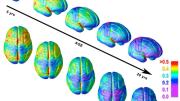Your teenage daughter gets top marks in school, captains the debate team, and volunteers at a shelter for homeless people. But while driving the family car, she text-messages her best friend and rear-ends another vehicle.
How can teens be so clever, accomplished, and responsible—and reckless at the same time? Easily, according to two physicians at Children’s Hospital Boston and Harvard Medical School (HMS) who have been exploring the unique structure and chemistry of the adolescent brain. “The teenage brain is not just an adult brain with fewer miles on it,” says Frances E. Jensen, a professor of neurology. “It’s a paradoxical time of development. These are people with very sharp brains, but they’re not quite sure what to do with them.”
Research during the past 10 years, powered by technology such as functional magnetic resonance imaging, has revealed that young brains have both fast-growing synapses and sections that remain unconnected. This leaves teens easily influenced by their environment and more prone to impulsive behavior, even without the impact of souped-up hormones and any genetic or family predispositions.
Most teenagers don’t understand their mental hardwiring, so Jensen, whose laboratory research focuses on newborn-brain injury, and David K. Urion, an associate professor of neurology who treats children with cognitive impairments like autism and attention deficit disorder, are giving lectures at secondary schools and other likely places. They hope to inform students, parents, educators, and even fellow scientists about these new data, which have wide-ranging implications for how we teach, punish, and medically treat this age group. As Jensen told some 50 workshop attendees at Boston’s Museum of Science in April, “This is the first generation of teenagers that has access to this information, and they need to understand some of their vulnerabilities.”
Human and animal studies, Jensen and Urion note, have shown that the brain grows and changes continually in young people—and that it is only about 80 percent developed in adolescents. The largest part, the cortex, is divided into lobes that mature from back to front. The last section to connect is the frontal lobe, responsible for cognitive processes such as reasoning, planning, and judgment. Normally this mental merger is not completed until somewhere between ages 25 and 30—much later than these two neurologists were taught in medical school.
There are also gender differences in brain development. As Urion and Jensen explain, the part of our brain that processes information expands during childhood and then begins to thin, peaking in girls at roughly 12 to 14 years old and in boys about two years later. This suggests that girls and boys may be ready to absorb challenging material at different stages, and that schools may be missing opportunities to reach them.
Meanwhile, the neural networks that help brain cells (neurons) communicate through chemical signals are enlarging in teen brains. Learning takes place at the synapses between neurons, as cells excite or inhibit one another and develop more robust synapses with repeated stimulation. This cellular excitement, or “long-term potentiation,” enables children and teenagers to learn languages or musical instruments more easily than adults.
On the flip side, this plasticity also makes adolescent brains more vulnerable to external stressors, as Jensen and Urion point out.
Teen brains, for example, are more susceptible than their adult counterparts to alcohol-induced toxicity. Jensen highlights an experiment in which rat brain cells were exposed to alcohol, which blocks certain synaptic activity. When the alcohol was washed out, the adult cells recovered while the adolescent cells remained “disabled.” And because studies show that marijuana (cannabinoid) use blocks cell signaling in the brain, according to Jensen, “We make the point that what you did on the weekend is still with you during that test on Thursday. You’ve been trying to study with a self-induced learning disability.”
Similarly, even though there is evidence that sleep is important for learning and memory, teenagers are notoriously sleep-deprived. Studying right before bedtime can help cement the information under review, Jensen notes. So can aerobic exercise, says Urion, bemoaning the current lack of physical-education opportunities for many American youths.
Teens are also bombarded by information in this electronic age, and multitasking is as routine as chatting with friends on line. But Jensen highlights a recent study showing how sensory overload can hinder undergraduates’ ability to recall words. “It’s truly a brave new world. Our brains, evolutionarily, have never been subjected to the amount of cognitive input that’s coming at us,” she says. “You can’t close down the world. All you can do is educate kids to help them manage this.” For his part, Urion believes programs aimed at preventing risky adolescent behaviors would be more effective if they offered practical strategies for making in-the-moment decisions, rather than merely lecturing teens about the behaviors themselves. (“I have yet to meet a pregnant teenager who didn’t know biologically how this transpired,” he says.)
By raising awareness of this paradoxical period in brain development, the neurologists hope to help young people cope with their challenges, as well as recognize their considerable strengths.









